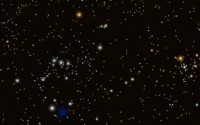Celestial navigation – Follow your star
- Date
- 16 Nov 2009
- Start time
- 7:30 PM
- Venue
- The Hospitium
- Speaker
- Sam Watson

Joint lecture with the Royal Geographical Society and PLACE
Celestial navigation follow your star
by Sam Watson, Terrington School
Since man’s first awareness of the stars above him as objects beyond merely the decorative or mystical, he has used them to guild his path and to navigate to fixed points on the planet around him. The talk presents an overview of the main methods used, from both a historical and navigational standpoint, with discussion as to how modern technology has updated celestial navigation with man’s placing of his own “stars” in the firmament – man-made satellites that now give pinpoint positional accuracy through GPS systems.
Sponsored by Royal Geographical Society & PLACE
Report
by Rod Leonard
A brief comparison was made between terrestrial navigation with maps and compass, and celestial navigation with astrolabes, octants, quadrants, and the more accurate sextant. The north celestial pole (identified to 1 degree by Polaris), celestial equator, and celestial sphere were described. Terrestrial latitude can be calculated to within 2000m, with the aid of a sextant and an almanac, from the declination and sidereal hour angle of at least two known stars. Terrestial longitude can similarly be calculated provided GMT is known. On land, the use of a theodolite can increase accuracy to about 500m, but needs considerable setup time. The speaker had experience of this in the Sahara Desert, where a simple sun compass is also useful. GPS now gives very accurate locations, by measuring the position of artificial satellites from Doppler effects – however, its reliability can be affected by poor signals or by the system being unexpectedly switched off.